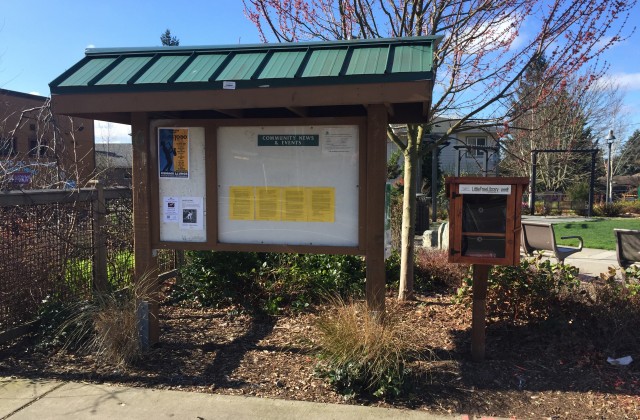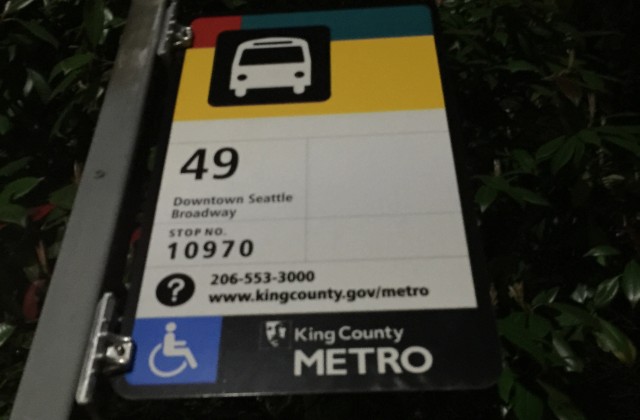Why Director’s Rule Won’t Solve Parking and Affordability Issues
I’ve been getting the calls for weeks now about projects that are being adversely impacted by a Hearing Examiner Decision back in December that changed the way frequent transit service is calculated. The Hearing Examiner ruled that the GIS map and averaging the gaps between the arrival and departure of buses could no longer be used to establish that a housing project is in an area with frequent transit service, with gaps no greater than 15 minutes between buses. In response to the ruling, the Department of Planning and Development (DPD) has issued a new rule, and new housing must be no further than 1320 feet from a bus stop and meet a different requirement. While this new rule preserves the exemption to new projects that would otherwise have to build expensive parking, it still doesn’t go far enough. Here’s why.
The proposed new rule would provide exemption for projects within 1320 feet of a bus stop.
a. Multiple routes at the same stop may be included; and b. Multiple transit stops within 1,320 feet walking distance may be included provided the transit is going in the same direction.
2) Identify on the plans submitted with the permit application, copies of the transit schedules indicating the service headways (“headways” are the amounts of time between scheduled bus service at a given location) for the transit stop(s) identified in Step 1:
a. For a minimum of 12 hours, 6 days per week, transit service headways must be 15 minutes or less; andDirector’s Rule __-2015 Page 3 of 3
b. For a minimum of 18 hours per each day of the week, headways must be 30 minutes or less.
I’ve already heard from one builder who has a Small Efficiency Dwelling Unit (SEDU) proposal on about 5000 square feet in what would have neatly fit onto the GIS maps frequent transit service area. And this project would have easily qualified under the averaging method which the Hearing Examiner explicitly threw out for the project subject to her ruling, a ruling DPD has chosen to interpret as applying broadly, to all projects already in permitting.
But what about using the new rule? The project still falls short because it can’t count bus routes on both sides of the street within the 1320 foot range. That means under the new rule’s strict “one direction” provision the project can’t count the many routes going back and forth in various directions within 1320 feet.
OK, well, why not just include parking as required? The site is too small. Adding the required 1 spot per unit requirement would be impossible and make the project technically and financially infeasible. So instead of getting 25 to 30 SEDU apartments priced for people who around 80 percent of Area Median Income (AMI), the site will have just one, single-family home. And keep in mind recent legislation changing the requirements for SEDUs to be included in the Multifamily Tax Exemption (MFTE) Program and unit reducing low-rise legislation, what would have been an ideal low-rise project has been stamped out of housing production. This doesn’t even take into account Councilmember O’Brien’s tax on new housing which would have added more costs.
Instead of a compact, transit oriented, affordable, pedestrian friendly housing project for as many as 30 or 40 people, the city will now have one big single-family house. But maybe that’s the way City leaders and neighborhoods want it. If that’s the case, why bother holding endless meetings about housing affordability. It won’t happen if we keep piling on with more and more bad policy and regulations. Legislation putting the word “average” in the ordinance would fix this problem. Does the City Council have the courage to do that?
City Builder:New Housing Comes with Free Books
Developing properties is, in the most literal sense, a community affair. And that’s the case with one of Village Builders’ latest projects in Morgan Junction, West Seattle. It’s one of those projects that makes people stand up and take notice because it involves community in the truest sense of the word.
|
Village Builders Company Founded: 2013 Development Type(s): Urban, in-fill housing to Built Green Four Star standards Number of Projects per Year: 5 |
Village Builders’ principals live in the area. Joe Paar lives in Morgan Junction and Tyler Jamison lives close by. The firm is involved in the comprehensive plan for the Church of the Nazarene in Morgan Junction, which sits on a piece of land that has gone largely unused. When the church decided to undergo a renovation, they also chose to put some of the 30,000 square feet of land it sits on to better use. Some of the space has been allocated for six new townhomes to be built by Village Builders, while about 10,000 square feet has been set aside to create a private park—for public use; a “do unto others” gesture translated into the modern day.
As a part of any new development, especially one this unique, many decision must be made by a diverse array of people including the church, builders, developers, architects, city representatives and neighborhood associations. In this case, all of the players meet quarterly at the Morgan Junction Community Association to discuss how this development fits in with the community’s overall plans. Up for discussion at the Fall 2014 meeting was Morgan Junction Park, where the Community Association is highly involved in upkeep and beautification.
Influential Morgan Junction residents and leaders Chas Redmond, Deb Barker and Cindy Barker felt the park would benefit from the installation of a Free Little Library, the tiny pop up repositories that encourage community members to “take a book, return a book” so neighbors can share their favorite literature.
That’s where Paar and Jamison came in. They took the idea and ran with it and installed (with city approval of course) a Free Little Library right next to the park’s information kiosk. By embracing the sense of community engendered by the Church of the Nazarene and the Morgan Junction Community Association, the entire community’s wishes became a reality. Now, Morgan Junction Park’s very own Free Little Library is open for business.
San Francisco: What a Real Debate About Housing Looks Like
I pointed out how desultory the City Council’s discussion about housing has become. Councilmembers seem to be sleepwalking through the most important discussion our city has ever had about housing. Instead of engaging with the community and each other, Councilmembers are rubber stamping legislation that will end up doing serious damage to housing affordability. However, in San Francisco, Supervisors (Supervisors are like our Councilmembers) actually have strong and divergent opinions about housing and they argue with each other in public about supply and demand and land use regulation. Supervisor Scott Wiener is a vocal and aggressive supporter of increasing housing supply. When told he was pro-development, Wiener said, “I like to refer to it as pro-housing. Housing only gets created through development.” In an article he wrote called, “Yes, Supply and Demand Apply to Housing,” Wiener took on a proposed moratorium on building in the Mission.
Yes, you heard that right: In order to combat ridiculously high housing prices and in the face of long-term population growth that shows no signs of abating, let’s put a moratorium on building new housing other than government-funded housing.
These arguments don’t hold water. Indeed, in recent history, we’ve never come close to producing enough housing to allow anyone to argue that increasing housing supply doesn’t stabilize housing prices. But, we do have evidence to the contrary. Since 2003, San Francisco has grown by nearly 100,000 people, while producing around 24,000 units of housing. During that same time period, housing prices have gone through the roof.
On the other side of the debate is Supervisor David Campos who took on Wiener’s article directly, saying, “Something unsettling has occurred – the ghost of Ronald Reagan has spoken from the grave and he’s chosen a San Francisco Supervisor as his mouthpiece.” Campos explains the reasoning behind the moratorium in the Mission.
The group has called upon the board of Supervisors and the Mayor to do three things: fast track the development of affordable housing in the Mission; pass interim controls to preserve land for affordable housing development in the neighborhood; and form a special use district, with controls similar to those in Japantown, to preserve the neighborhoods unique historic and Latino character. Ironically, the same colleague who has criticized Calle 24’s recommendations, recently introduced similar development controls on what he calls “monster houses” being built in his own neighborhood. Free marketeers often try and stop poor communities from having a voice in development, but are happy to exchange their ‘supply and demand’ hat for a nimby hat when it comes to protecting their own backyard.
Instead of leaving the substantive debate about supply and demand to the comments sections of local blogs, Supervisors are taking off the gloves to argue about what one local paper calls an “epic housing fight.” Forces are already assembling on both sides of the issue.
Pro-housing advocates have said that the lack of new market-rate housing in the Mission is what is driving gentrification there. Since 2000, about 1,500 new units of housing has been constructed, according to Planning Department data. The city still expects about 1,400 new units to be built over the next two decades, according to the neighborhood’s 2009 rezoning. Mission advocates, meanwhile, point to the fact that the Mission transformed from 50 percent Latino to 39 percent Latino between 2000 and 2010 as low-income residents headed for cheaper neighborhoods.
Imagine as Seattle where there was a City Council that wasn’t monolithic and staff driven in it’s approach to housing, engaging in real intellectual debate rather than simply choosing from column A or column B when making important policy. Perhaps the election will light a fire under the debate, or maybe the Councilmembers will just keep avoiding the real questions with a shrug.
New Directors Rule Will Restore Some Parking Exemptions
In response to a Hearing Examiner’s decision that eliminated using a GIS map and an averaging of headways to determining frequent transit, the Department of Planning and Development (DPD) has issued a new clarifying rule about parking exemptions in those area. The decision by the Examiner in December had cast doubt over many housing projects already in the permitting process that were already designed without parking based on the previous interpretation of how to calculate the wait times between buses. The new rule appears to solve many of the problems. But it’s still unclear how many projects remain infeasible or whether the new rule will withstand further appeals.
There are two critical points in the new rule.
Multiple routes and multiple transit stops may be identified to demonstrate transit at FTS levels as follows:
a. Multiple routes at the same stop may be included; and
b. Multiple transit stops within 1,320 feet walking distance may be included provided the transit is going in the same direction.
The important element here is the fact that more than one route can be counted. So a bus stop with gaps between buses of 10 minutes, for example, counts as frequent transit even if the routes are the 7, 36, and 43. But the buses have to be going the same direction; the bus top across the street doesn’t count.
The 12 and 18 hour durations for measuring frequent transit service don’t have to be consecutive. This is how DPD is getting around the Examiner’s ruling against using averages.
The time periods during each day that the above headways are provided need not be consecutive. For example, the first requirement is met if transit service headways are 15 minutes or less for a total of 12 hours during an individual day, even if that 12 hours is broken into two or more periods during which the 15-minute headway standard is met, separated by periods during which that standard is not met.
Estimates are that new rule will allow about 75 percent or so of proposed projects to survive with the exemption. The ones that won’t make it depend on aggregating multiple transit lines or depend on routes that are traveling in different directions.
We’re still reviewing the rule and how many housing units and projects might be lost. Everyone agrees the best solution is legislation. Until then the new rule will have to do. The text of the new rule is below in full. Send your comments or thoughts to Mike.Podowski@Seattle.gov
—————–
Purpose
The purpose of this rule is to define the Department’s requirements for demonstrating that a development site is eligible to be developed without parking (pursuant to 23.54.015 Table A, Row J or Table B, Row M) or qualifies for a 50% reduction in amount of required parking (pursuant to 23.54.020.F) due to the site’s location within walking distance of frequent transit service (FTS).
Background
To promote environmental and transportation policies of the Comprehensive Plan and support alternatives to driving, either no parking is required, or a reduction in the required amount is allowed for residential uses in multifamily and commercial zones in areas of the city where transit service is adequate to serve commute and non-work related trips.Director’s Rule __-2015 Page 2 of 3
Seattle Municipal Code (SMC) Tables A, B, and C for 23.54.015, Required Parking for Uses (paraphrased):
No parking is required for uses (except hospitals) in commercial and multifamily zones within urban villages if the use is located within 1,320 feet (a quarter mile) of a street with frequent transit service, measured as the walking distance from the nearest transit stop to the lot line of the lot containing the use.
SMC 23.54.020.F, Reductions to minimum parking requirements (paraphrased):
…In multifamily and commercial zones, the minimum parking requirement for all uses (except hospitals, including those that are designated major institutions) is reduced by 50 percent if the use is located within 1,320 feet of a street with frequent transit service…
SMC 23.84A.038 “T” includes the definition of “Transit service, frequent” (paraphrased):
Transit service is available with headways in at least one direction of 15 minutes or less for at least 12 hours per day, 6 days per week, and 30 minutes or less for at least 18 hours every day.
Rule
To demonstrate that a site is within walking distance of Frequent Transit Service (FTS) follow these steps:
1) Identify on plans submitted with the permit application the location of the development site and the location of transit stop(s) with the 1,320 foot walking distance clearly marked. The distance shall be measured as the walking distance (along sidewalks or other legal walking routes and legal street crossings) from the nearest portion of the property line(s) to the transit stop(s) main sign, transit shelter or the yellow and red painted curb (painted by the Seattle Department of Transportation). Only one transit stop need be identified and it may be on the same side of the street or the opposite side as the development site. Multiple routes and multiple transit stops may be identified to demonstrate transit at FTS levels as follows:
a. Multiple routes at the same stop may be included; and b. Multiple transit stops within 1,320 feet walking distance may be included provided
the transit is going in the same direction.
2) Identify on the plans submitted with the permit application, copies of the transit schedules indicating the service headways (“headways” are the amounts of time between scheduled bus service at a given location) for the transit stop(s) identified in Step 1:
a. For a minimum of 12 hours, 6 days per week, transit service headways must be 15 minutes or less; and
Director’s Rule __-2015 Page 3 of 3
b. For a minimum of 18 hours per each day of the week, headways must be 30 minutes or less.
The time periods during each day that the above headways are provided need not be consecutive. For example, the first requirement is met if transit service headways are 15 minutes or less for a total of 12 hours during an individual day, even if that 12 hours is broken into two or more periods during which the 15-minute headway standard is met, separated by periods during which that standard is not met.
The following is an example:
West Seattle Junction Neighborhood Example at 35th Ave SW/SW Avalon Way
1)
2)
Identify the transit route(s) that serve a stop within 1,320 feet (1/4 mile) from the development site to the bus stop sign. This will vary according to where the development site is located within an urban village.
INFO SOURCES: http://metro.kingcounty.gov/schedules/ or http://pugetsound.onebusaway.org/where/standard/
Routes for the vicinity of 35th Ave SW/SW Avalon Way are: Rapid Ride C and Route 21
For the selected routes, using the attached worksheet or similar, count the number of buses that stop to pick up passengers within each hour for the following time periods: 12 hours, 6 days/week (use the weekday and Saturday schedules); and 18 hours, each day of the week (which means schedules for Sunday must also be checked).
3) Review the combined list of service times. Are there any gaps between pickups that are more than 15 minutes? If yes, those periods of time may not be counted toward meeting the required 12-hour or 18-hours of transit service. Does the total time when frequent transit service is available still exceed 12 hours or 18 hours of the day?
Council Does More Damage to Affordability Without Debate
I think the Seattle City Council has forgotten what a legislative body does: debate issues. Yesterday the City Council, with very little process or discussion, plowed ahead and passed substantial changes to the Multifamily Tax Exemption (MFTE) Program for Small Efficiency Dwelling Units or SEDUs, the new version of microhousing created by the City last summer with the passage of Councilmember Mike O’Brien’s legislation. The Council is rapidly losing intellectual and political credibility as it makes decisions that will have huge impacts on housing without substantial discussion of the facts.
The Council has become monolithic in their support of punitive fees and overly simple changes to programs that have been working for renters. Their questions are superficial and fail to raise the most serious issues about where the greatest need for housing might be and what the best tools are to address it. I feature a debate from the House of Commons above to show what actual debate looks like. We don’t have debate at the Seattle City Council. We have Councilmembers who can’t debate housing issues in person or in public because they either don’t know the facts or want to ignore them. It makes them uncomfortable to confront ideas different from their own.
-
David Moser Simpler version: in your view does the market need subsidies/exemptions at 60-80% AMI or not?
Clark: But wait, Mr. Valdez, I thought you said we don’t have a workforce housing problem. I don’t mean to play “gotcha,” but gotcha. Over and over again you’ve gone to pains to point out how we don’t need more subsidies at 60 to 80 percent. Now that we’re trying to lower the income to help the levels of income you and John Fox said need the most help, you’re crying foul. So what is it, Mr. Valdez, do people in SEDUs who earn between 60 to 80 need help or not?
Valdez: I thank my Honorable Colleague for paying attention. Yes, indeed, we have said that we don’t need subsidies for people earning 60 to 80 percent AMI because there is a surplus of housing affordable to people who earn that much. But I guess I have to remind my colleague that part of the reason we don’t need a linkage tax for those levels of income is because, in no small part, the MFTE program is working already for those levels of income. The proponents of the linkage tax want to tax renters (for they are the ones that will ultimately pay the tax) who earn 60 to 80 percent to subsidize other renters who earn 60 to 80 percent. This is true because when we tax new rental housing, that tax will end up hitting those levels of income the hardest. They will end up down renting, pushing up prices of older housing and making it harder for people at even lower levels of income.
But we’re not talking about the linkage tax of course, we’re talking about SEDUs. The issue here is whether we are “fixing” MFTE or simply ending it for SEDUs. The information you’ve been given from the Office of Housing are rents based on mircrohousing, which you’ve eliminated. And guess what, prices for SEDUs are HIGHER than for microhousing, just as we said they would be. Instead of $900 micros we have $1200 or $1400 SEDUs because there are fewer of them and they are bigger with more sinks and bike parking than anyone needs. You made that decision.
Therefore, lowering the entry level to 40 percent for the program means that the tax benefits are exceeded by the rent concession, a situation that isn’t an incentive it is a penalty (which it is easy to think is what you’re really after).
The question about what and where to use the very useful MFTE program is a good one. But you didn’t ask that before proposing this legislation. We’d have been happy to engage in that discussion. But there was none. You simply highlighted and deleted. “65 Percent” and the replaced it with “40 percent;” highlighted “20 percent of the units” deleted it, and replaced it with “25 percent.”
You did nothing to find out what impact this would have, engaged nobody who builds these, and simply went along passing the legislation knowing full well that because this is a complicated program to explain that you and your colleagues would look like heros and we would look like whiners.
What you lack in ability as a policy maker, I concede, you almost make up for in your shrewdness at the use of your office to make renters feel better, even while you are removing real benefits to them.
-
Roger Valdez Again, a great question, Mr. Whisner.
Both the levy and MFTE cost all property owners and those that rent from them. However, when we consider that the median home about pays about $10.49 per year to create over 4000 rent restricted units, we think i…See More -
Bill Kirlin-Hackett 4,000 rent restricted units, none at 40%? True? Let those who need such rent go elsewhere; in fact, commute, clog the roads on the way to Seattle jobs. After all, that’s not the builders’ problem.Housing near jobs… Right? The market will provide. An…See More
-
Roger Valdez Bill why would a bank or investor loan a baker, for example, to make bread if the baker couldn’t pay them back because the Council lowered the price of bread?
Nobody has argued here there isn’t a need, but simply cutting and pasting “40 percent” won’t create more affordable units. It won’t.











